
12 Best Content Management Systems in 2025 - Review and Comparison
A well-chosen CMS can dramatically simplify your company's content management while increasing the efficiency of your editorial and IT teams. However, the growing number of available CMS platforms makes it difficult to make the right choice. In this article, we take a look at the 13 best content management systems in 2025, along with a detailed comparison to help you find the perfect solution for your business.
In this article:
- Why is choosing a content management platform crucial?
- Criteria for selecting the best CMS platforms in 2025
- 1. Drupal
- 2. WordPress
- 3. Contentful
- 4. Adobe Experience Manager
- 5. Umbraco
- 6. HubSpot CMS
- 7. Strapi
- 8. Joomla
- 9. Sitecore
- 10. Magnolia CMS
- 11. Optimizely
- 12. Kentico
- How to choose the best CMS platform in 2025?
Why is choosing a content management platform crucial?
A CMS software is the foundation of an organization's digital presence. The wrong choice results in development limitations, high maintenance costs, and security issues. The average company changes its content management system every 3-5 years, mainly due to an ill-considered initial decision.
The best CMS platform must support content distribution in multiple channels, provide high security standards, enable real-time personalization, and integrate with marketing and analytics tools.
The right choice of content management system translates directly into business success:
- team efficiency - an intuitive interface allows editors to focus on valuable content creation instead of struggling with the system,
- business scalability - a flexible CMS grows with your organization, handling more traffic and more content,
- data security - robust security protects against cyber attacks and ensures compliance with international regulations,
- return on investment (ROI) - thoughtful CMS selection minimizes long-term maintenance and development costs.
Criteria for selecting the best CMS platforms in 2025
Evaluating content management systems requires the use of clear and measurable criteria that take into account both an organization's current needs and future challenges. Further in the article, we will analyze each platform in terms of five key areas that determine the success of the implementation and the long-term value of the content management system.
Usability and intuitive operation
The ease of daily use of the system directly affects the productivity of the team. A user-friendly interface increases CMS acceptance among users and reduces the need for training. In 2025, visual drag-and-drop editors and the ability to edit content directly on the page become standard.
Integration capabilities
The best content management systems must connect seamlessly with other business systems. Support for modern API standards, availability of off-the-shelf connectors and the ability to integrate with CRM tools, e-commerce, marketing automation, and ERP systems are key. The era of platforms operating in isolation is definitely over - companies expect a unified ecosystem of tools.
Scalability
A platform must be able to cope with traffic growth, expanded functionality, and increasing amounts of website content. Scalability encompasses both technical performance under heavy load and the ability to support multiple websites, languages, or branches within a single system. Enterprises often need global solutions that can handle millions of users simultaneously.
Security
In an era of increasing cyber threats, the security of a CMS solution is a top priority. Frequent security updates, advanced permission systems, and support for multi-factor authentication are important. For regulated industries, compliance with international security standards such as ISO/IEC 27001, SOC 2, and GDPR is crucial.
Support and community
The best CMS platform requires technical support and a community of users. Open source systems offer free community support, documentation, and discussion forums. Commercial solutions provide professional vendor support with guaranteed response times. The choice depends on the complexity of the project and the team's internal competence.
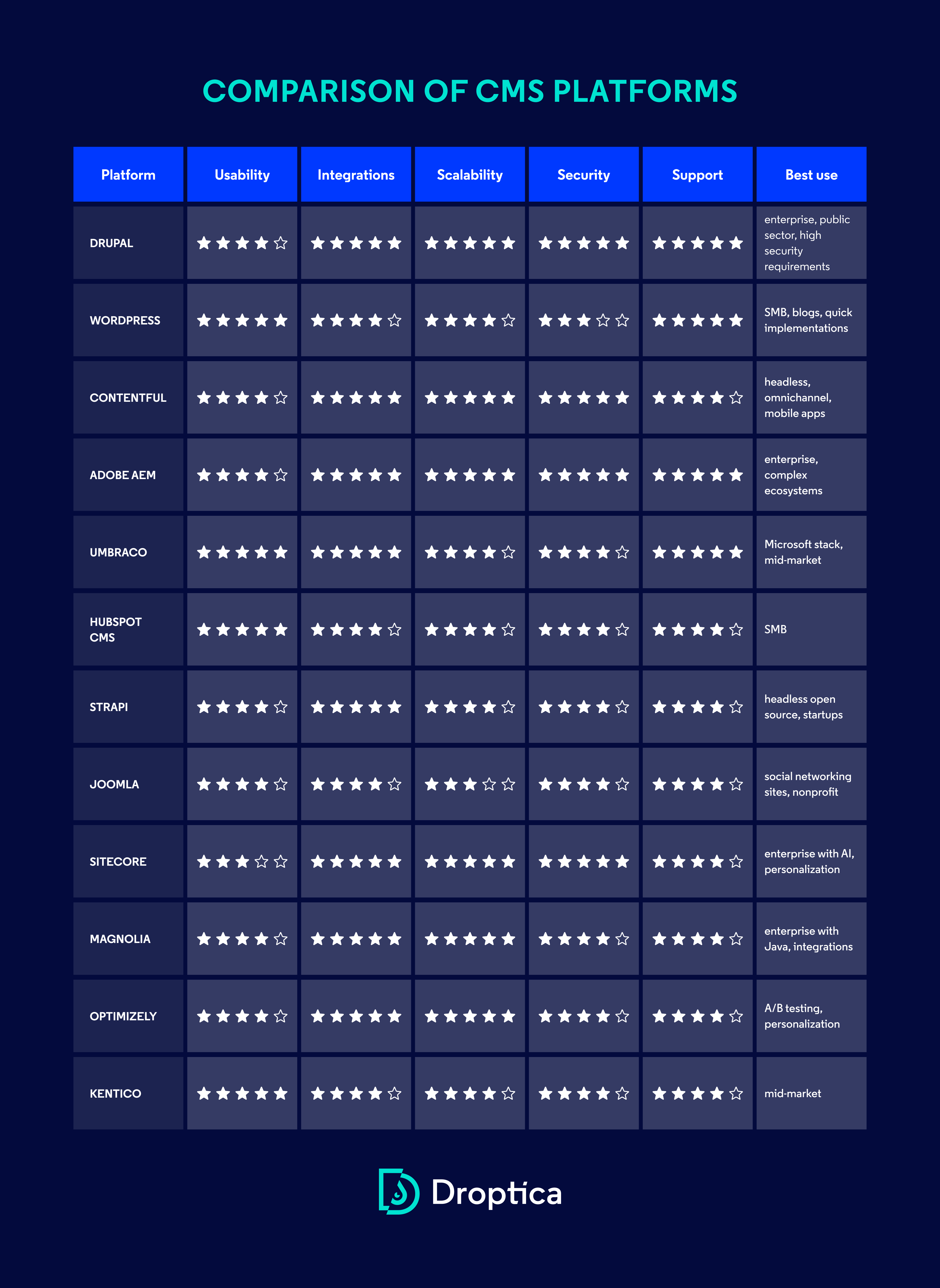
1. Drupal
Drupal is an open source CMS platform that specializes in handling complex enterprise projects and solutions for public institutions. It is used by governments, higher education, and global corporations. Drupal is distinguished by its advanced content management capabilities, flexible architecture and high security standards.
Usability and intuitive operation
Drupal CMS, introduced in January 2025, has significantly improved the usability of the platform. Experience Builder (scheduled for October 2025) offers real-time visual editing and drag-and-drop page creation without knowledge of code.
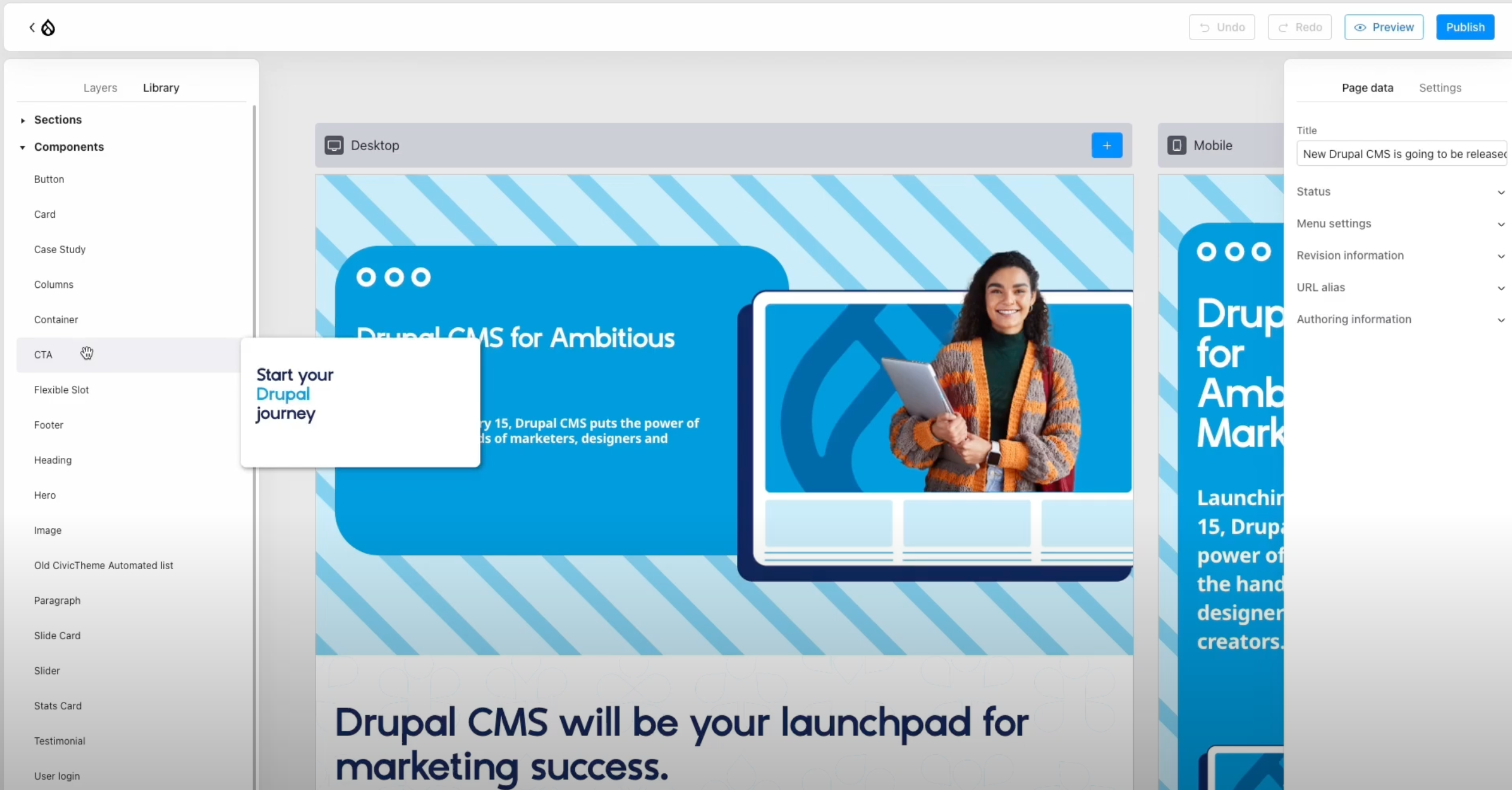
Source: Drupal Experience Builder - Part 1
The Desktop Launcher App allows one-click installation, eliminating the need for server configuration. The admin panel includes a dashboard with customizable blocks tailored to user roles - editor, moderator, or administrator.
Integration capabilities
Drupal offers a comprehensive integration ecosystem. Native support for REST API, JSON:API, and GraphQL enables seamless integration with CRM systems (Salesforce, HubSpot), e-commerce platforms (Shopify, Magento), marketing automation tools (Marketo, Pardot), and ERP systems (SAP, Oracle). More than 50,000 Drupal modules in the official repository cover virtually every business need. Thanks to its modular architecture, the integration of new systems does not require code rewriting.
Scalability
The platform uses advanced caching mechanisms at multiple levels and integrates with global CDNs like Fastly and CloudFlare. The system can handle millions of page views per day with the right infrastructure configuration. Drupal natively supports multisite and multilingual configurations, allowing you to manage dozens of sites from a single admin panel.
Security
Drupal has a dedicated security team of more than 50 experts who publish regular security updates. The platform offers full ISO27001 compliance, built-in modules for GDPR support, and advanced data encryption. Drupal is chosen by government institutions with high security requirements. A permissions system allows precise management of access to content at the level of users, roles and specific operations.
Support and community
Drupal has a community of more than one million active members, with more than 1,500 web developers contributing to the platform's code every month. Annual DrupalCon conferences in Europe and North America and hundreds of local DrupalCamp events provide access to the latest knowledge and networking opportunities. You can also take advantage of the rich documetation on Drupal.org. Many companies specialize in paid Drupal support services.
2. WordPress
Originating as a blogging tool, WordPress now serves as the basis for a wide variety of site types - from simple business websites to complex media portals and ecommerce stores. The CMS platform is distinguished by its low entry threshold, extensive plugin ecosystem, and active developer community.
Usability and intuitive operation
WordPress offers a Gutenberg block editor with more than 200 available block types. This editor allows you to create pages by drag-and-drop without technical skills.
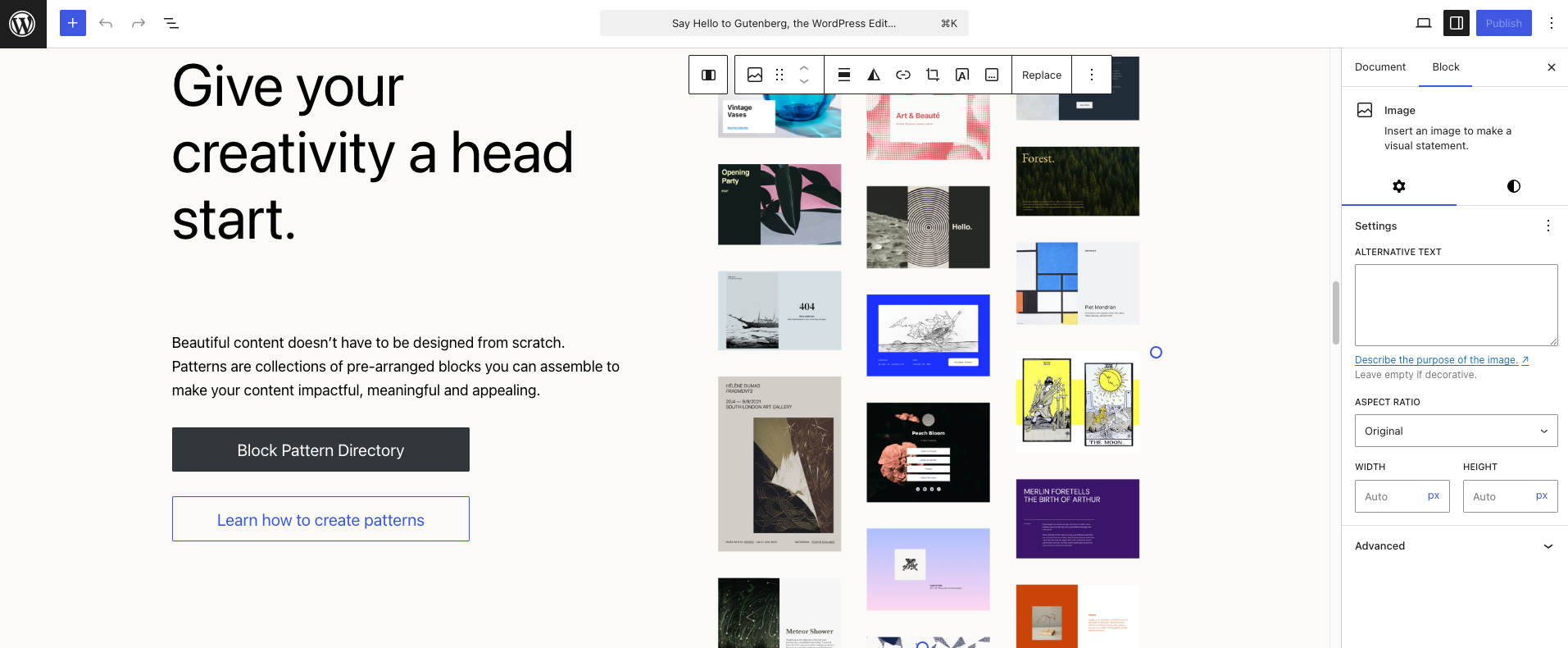
The ability to edit a block in the Gutenberg editor demo.
WordPress Dashboard organizes all functions in a clear menu - from content management to media to search engine optimization settings. The theme system allows you to change the look of your entire site with a single click, and live preview allows you to preview changes before publishing.
Integration capabilities
WordPress has an ecosystem of extensions, with more than 59,000 plugins available in the official repository. The platform supports REST APIs, allowing integration with third-party tools and headless application development. Popular integrations include CRM systems (HubSpot, Salesforce), e-commerce tools (WooCommerce, Shopify), email marketing platforms (Mailchimp, ConvertKit), and analytics tools (Google Analytics, Hotjar).
Scalability
WordPress can support sites ranging from a few visitors per day to millions of page views per month, although larger projects require proper optimization. The platform supports server-level caching, CDN integrations and database optimization. The multisite system allows you to manage multiple sites from a single admin panel.
Security
WordPress automatically installs security updates for the core of the system, providing protection against known vulnerabilities. The platform offers two-factor authentication, SSL encryption and advanced permission systems. The extensive plugin ecosystem is both an advantage and a potential security risk.
Support and community
WordPress has the largest community among CMS systems, with more than 60 million users worldwide. The platform offers extensive documentation, thousands of video tutorials, and active support forums in various languages. Annual WordCamp conferences are held in dozens of countries. Commercial support from certified WordPress developers and hosting providers is available for business users.
3. Contentful
Contentful is a headless CMS platform that specializes in content management for mobile apps, websites, and other digital channels. Contentful is distinguished by its API-first architecture, which allows content to be distributed to any application and device without the limitations associated with traditional website templates.
Usability and intuitive operation
This CMS system offers an intuitive interface for content management that requires no technical knowledge. Content-Type Builder allows you to create custom content structures by defining text fields, images, dates, and content relationships. Content teams can work on articles in real time with the real-time collaboration feature. The platform offers content previews in various formats and the ability to schedule publications.
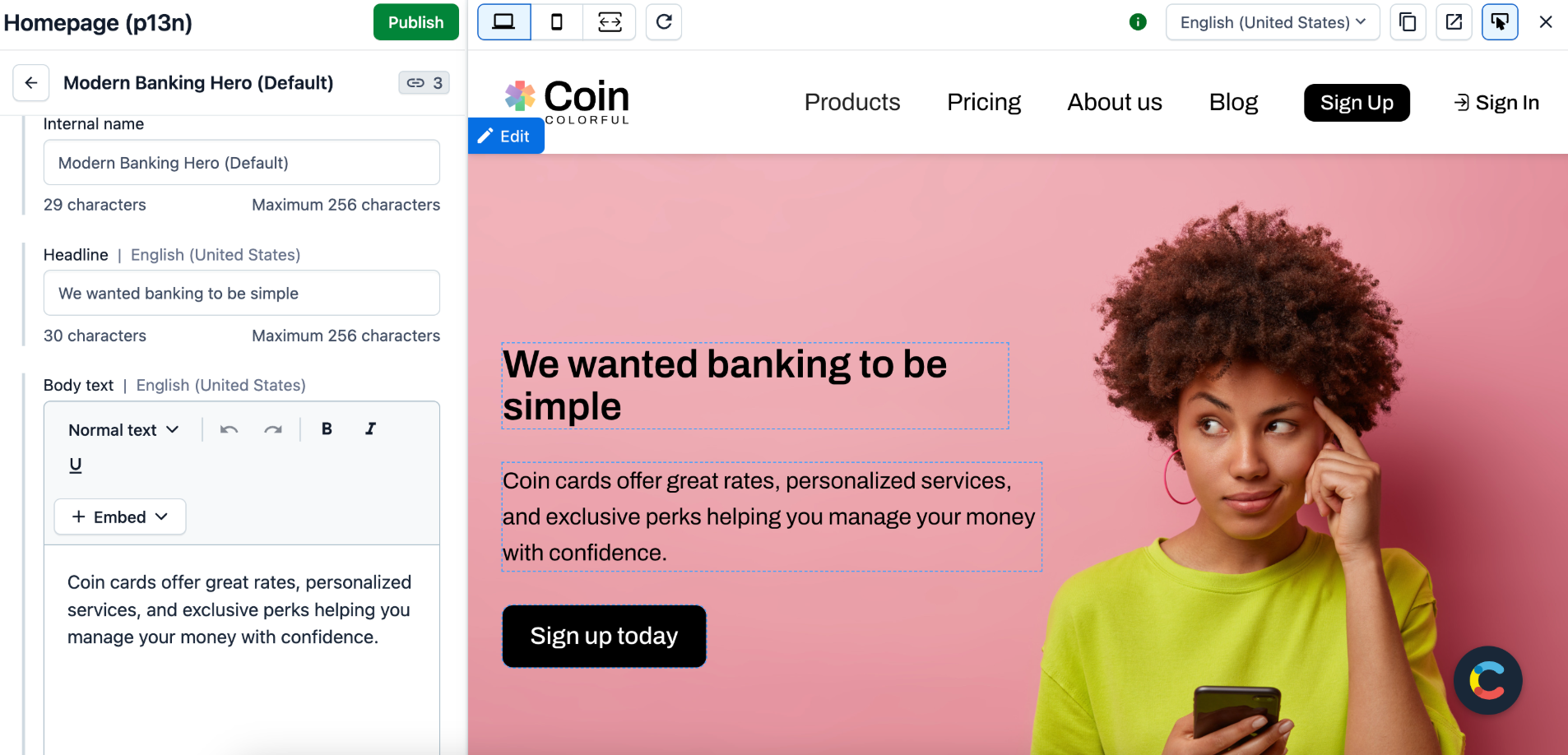
Previewing and editing a page. Source: Contentful
Integration capabilities
Contentful is based on an API-first architecture with full support for REST APIs and GraphQL. The platform offers more than 100 pre-built integrations available in the marketplace, including those with popular frameworks like React, Vue.js, Angular, and Next.js. Contentful integrates with tools like Zapier (enabling automation of more than 1,000 applications), Shopify for e-commerce, and analytics platforms like Google Analytics.
Scalability
Contentful runs fully in the cloud with automatic scaling of resources depending on load. The platform leverages Fastly's global CDN with more than 200 locations around the world to ensure fast loading of content regardless of user location. Contentful can handle millions of API requests per day and offers an SLA of 99.99% for enterprise plans.
Security
Contentful has ISO 27001, SOC 2 Type II certification, and is GDPR compliant. The platform offers data encryption at rest and during transmission using the AES-256 standard. A permissions system allows fine-grained management of access to content at the level of users, roles, and specific activities.
Support and community
Contentful offers 24/7 technical support for premium plans and dedicated managers for enterprise customers. The platform has extensive documentation, interactive tutorials, and an active developer community. Regular webinars and Contentful Connect conferences provide access to the latest features and best practices.
4. Adobe Experience Manager
Adobe Experience Manager is a commercial CMS platform that is part of the Adobe Experience Cloud suite. AEM is used by large enterprises such as Coca-Cola, Mercedes-Benz and Sony. The platform is distinguished by advanced content personalization capabilities, integration with Adobe tools, and digital asset management features.
Usability and intuitive operation
Adobe Experience Manager offers a WYSIWYG editor with drag-and-drop functionality that allows marketers to create pages from ready-made components without knowing the code. A template system allows users to create consistent experiences across the organization. Due to the complexity of the interface, the platform requires dedicated training.
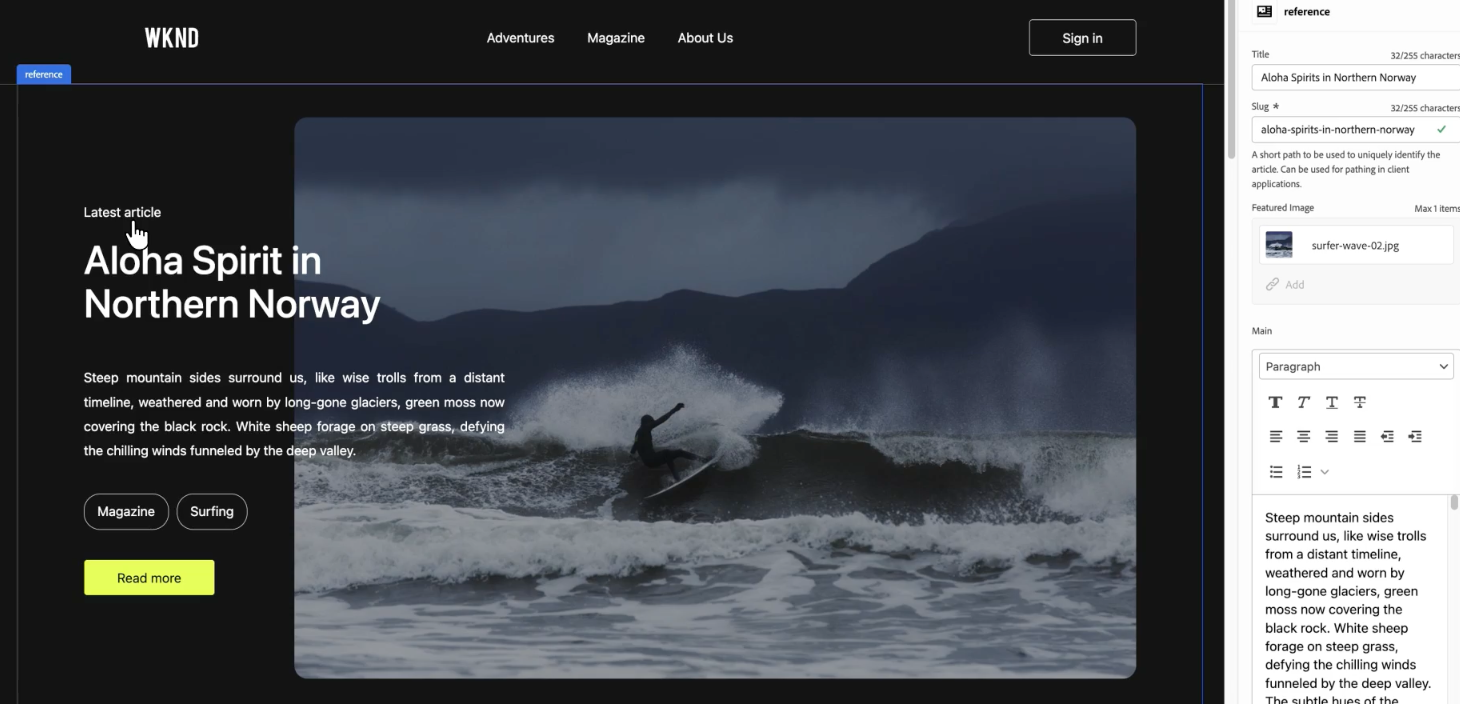
Universal Editor in the Adobe Experience Manager system. Source: Adobe
Integration capabilities
Adobe Experience Manager integrates natively with the entire Adobe Experience Cloud ecosystem, including Adobe Analytics, Adobe Target, and Adobe Campaign. The platform offers REST APIs and GraphQL interfaces. AEM integrates with popular CRM systems (Salesforce, Microsoft Dynamics) and marketing automation platforms (Marketo, Eloqua).
Scalability
Adobe Experience Manager uses a cloud-based microservices architecture with automatic resource scaling. The platform offers a global CDN and advanced caching mechanisms. AEM can handle millions of simultaneous users and supports global multilingual deployments.
Security
Adobe Experience Manager meets the highest enterprise security standards with ISO 27001, SOC 2 Type 2, HIPAA, and FedRAMP certifications. The platform offers end-to-end data encryption and advanced permission systems.
Support and community
Adobe Experience Manager offers dedicated 24/7 enterprise support and access to more than 1,000 certified partners worldwide. The platform has extensive Adobe training and certification programs and regular Adobe Summit conferences.
5. Umbraco
Umbraco is an open source CMS platform based on .NET technology. It stands out for its user-friendly interface, flexibility, and full integration with the Microsoft ecosystem.
Usability and intuitive operation
Umbraco offers Backoffice, an administration panel that allows intuitive content management without technical skills. Block-level Variants in version 15 make it easy to create and manage multilingual content. The platform offers a drag-and-drop page builder, customizable dashboards, and the ability to create custom workflows for editorial processes.
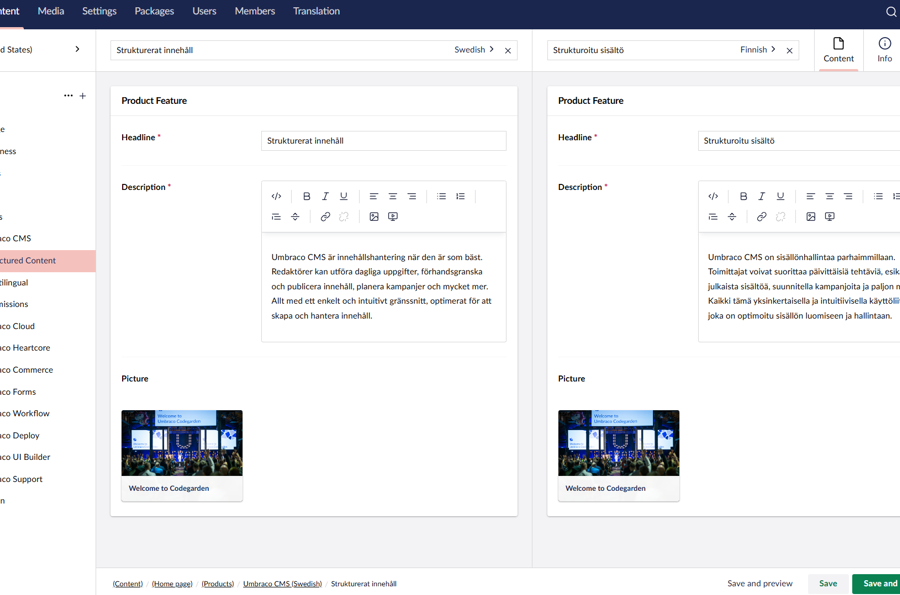
Content editing. Source: Umbraco
Integration capabilities
Umbraco integrates natively with Microsoft infrastructure, including Azure Cloud Services, Microsoft Entra ID, and Power Platform. The platform offers a REST API and Umbraco Heartcore, a headless CMS solution for mobile and SPA applications. Umbraco connects to popular CRM systems (Microsoft Dynamics, Salesforce) and email marketing tools (Mailchimp, Campaign Monitor).
Scalability
Umbraco can handle sites with millions of pages without performance degradation. The platform supports load balancing, clustering, and integration with Azure App Service for automatic scaling. Umbraco can be deployed on-premise, in the cloud, or in a hybrid configuration.
Security
Umbraco provides security through integration with Microsoft Azure infrastructure, which is certified to ISO 27001, SOC 2, and other compliance standards. The platform offers built-in GDPR support tools and the ability to easily integrate with Microsoft Entra ID for single sign-on.
Support and community
Umbraco has an active community of more than 250,000 developers and a network of more than 1,500 certified partners worldwide. Annual CodeGarden conferences and local meetups provide access to the latest knowledge. The platform offers different levels of commercial support - from community support to dedicated enterprise support with guaranteed SLAs.
6. HubSpot CMS
HubSpot CMS is a platform belonging to the HubSpot ecosystem. The system is used by more than 100,000 companies worldwide, mainly in the small and medium-sized business segment. HubSpot CMS is distinguished by its native integration with marketing, CRM, and sales automation tools in a single platform.
Usability and intuitive operation
HubSpot CMS offers a drag-and-drop editor that allows marketers to create pages without technical skills using ready-made modules and templates. The platform integrates an AI-based content generator that helps create text, meta descriptions, and headlines. The system allows easy management of contact forms, CTA buttons, and landing pages.
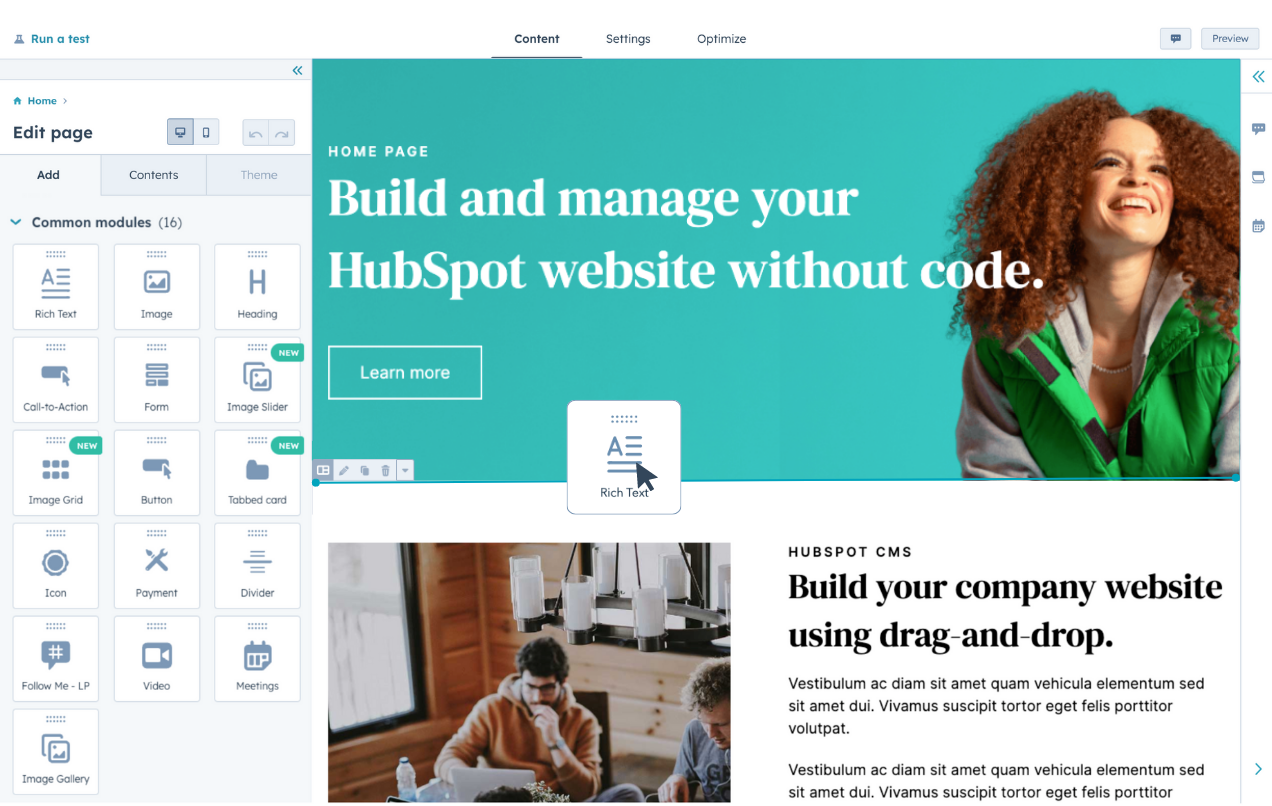
WYSIWYG editor. Source: HubSpot
Integration capabilities
HubSpot CMS is part of the broader HubSpot ecosystem, which includes CRM, marketing automation, sales tools, and customer service. The platform integrates with more than a thousand apps through the HubSpot App Marketplace, including popular tools like Shopify, Salesforce, Slack, and Zoom. HubSpot offers a REST API for creating custom integrations and webhooks for automating processes.
Scalability
HubSpot CMS runs fully in the cloud with automatic scaling and offers a 99.9% SLA. The platform uses a global CDN and advanced caching mechanisms for fast page loading. HubSpot supports sites from small businesses to medium-sized enterprises.
Security
HubSpot has SOC 2 Type 2 certification, ISO 27001 certification, and is GDPR and CCPA compliant. The platform offers SSL/TLS data encryption, two-factor authentication and SAML-based SSO for enterprise accounts. A user permissions system allows users to manage access to various functions and data.
Support and community
HubSpot offers 24/7 technical support for Professional and Enterprise plans and dedicated managers for larger customers. The platform has an extensive HubSpot Academy with free courses and certifications and an active user community. The company also has a network of more than 3,000 certified partners offering implementation and consulting services.
7. Strapi
Strapi is an open source headless CMS that has gained popularity due to its modern architecture and ease of use. The platform is used by companies such as IBM, NASA, and Toyota. Strapi is distinguished by full API control, self-hosting capabilities and flexibility in database selection.
Usability and intuitive operation
Strapi offers a modern React-based administration panel that allows intuitive content management without technical knowledge. Content-Type Builder allows you to define your own data structures through a drag-and-drop interface with different field types - text, numbers, dates, relationships, and media. The platform offers a system of roles and permissions to precisely manage access to content.
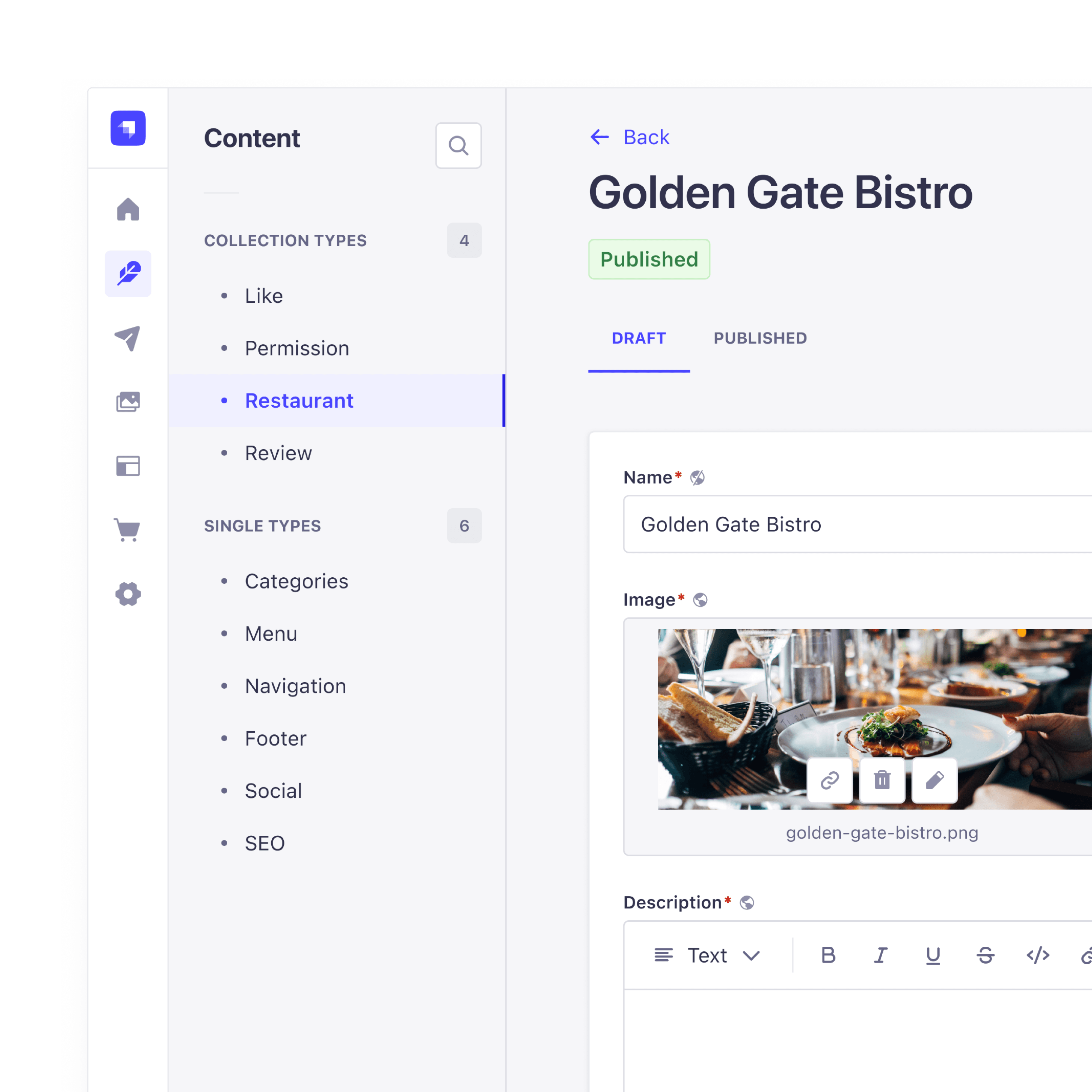
Source: Strapi
Integration capabilities
Strapi offers full support for REST APIs and GraphQL, allowing frontend applications to easily retrieve content. The platform integrates natively with popular JavaScript frameworks such as React, Vue.js, Angular, and Next.js. The platform can be deployed with various databases (PostgreSQL, MySQL, SQLite, MongoDB) and cloud services (AWS, Google Cloud, Azure).
Scalability
Strapi is based on Node.js and can be scaled both vertically and horizontally as needed. The platform supports load balancing, clustering, and integration with cloud services for automatic scaling. Strapi can handle medium to large sites, although it may require additional optimization for very large data volumes.
Security
Strapi offers advanced security features, including JWT authentication, OAuth 2.0, two factor authentication and role-based access control. The platform is regularly updated for security by a dedicated team. Strapi allows self-hosting, giving you full control over data security.
Support and community
Strapi has an active open source community. The platform offers extensive documentation, video tutorials, and integration examples. Strapi Enterprise provides dedicated technical support, SLAs, and additional features for larger organizations. Regular webinars and the Strapi Conference provide access to the latest features.
8. Joomla
Joomla is an open source CMS platform that is particularly popular in the education sector, nonprofit organizations, and for creating social networking sites. Joomla is distinguished by built-in support for multilingualism, an advanced permissions system and the ability to create complex content structures.
Usability and intuitive operation
Joomla offers a more advanced administrative interface than WordPress, which may initially intimidate new users, but provides greater control over content. Version 5.0 introduces dark mode, passkey authentication, and improved administration panel navigation. The platform offers an advanced category and tag system, which allows the creation of complex content structures without additional third-party extensions.
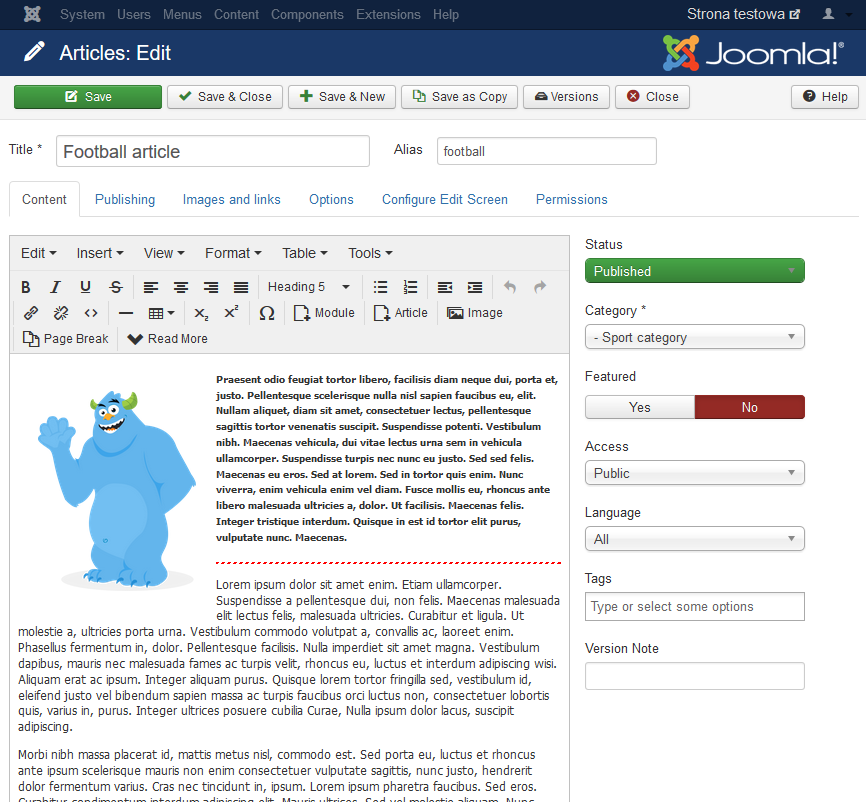
A text editor in the Joomla content management system. Source: Joomla-Monster
Integration capabilities
Joomla offers a REST API and more than 8,000 extensions available in the official catalog. The platform natively supports multilingual features without the need to install additional plugins, making it attractive for international projects. Joomla integrates with popular payment systems (PayPal, Stripe), e-commerce tools (HikaShop, VirtueMart), and newsletter systems (MailChimp, AcyMailing).
Scalability
Joomla can handle medium and larger sites, although with very high traffic, it may require additional server and database optimization. The platform uses MVC (Model-View-Controller) architecture, which provides a clear code structure. Joomla supports caching mechanisms, compression, and CDN integration for improved performance.
Security
Joomla has a dedicated Joomla Security Strike Team that monitors security threats and issues regular security updates. The platform offers built-in security features such as two-factor authentication, an advanced permissions system and protection against brute force attacks.
Support and community
This content management system has an active community of about 2 million users worldwide and extensive Joomla documentation available in multiple languages. Annual JoomlaDay conferences are held in various countries, and local user groups offer support. The platform offers official support forums and a wiki with technical documentation.
9. Sitecore
Sitecore is a commercial CMS and digital experience platform. It stands out for its advanced AI-based personalization capabilities, analytics and integration with marketing automation tools.
Usability and intuitive operation
Sitecore offers XM Cloud with an AI-powered interface that allows marketers to create personalized experiences without writing code. Due to the complexity of features and wealth of personalization options, the platform requires dedicated training. Experience Editor allows visual editing of pages in the context of the actual site, while Content Editor offers a more structured view of content.
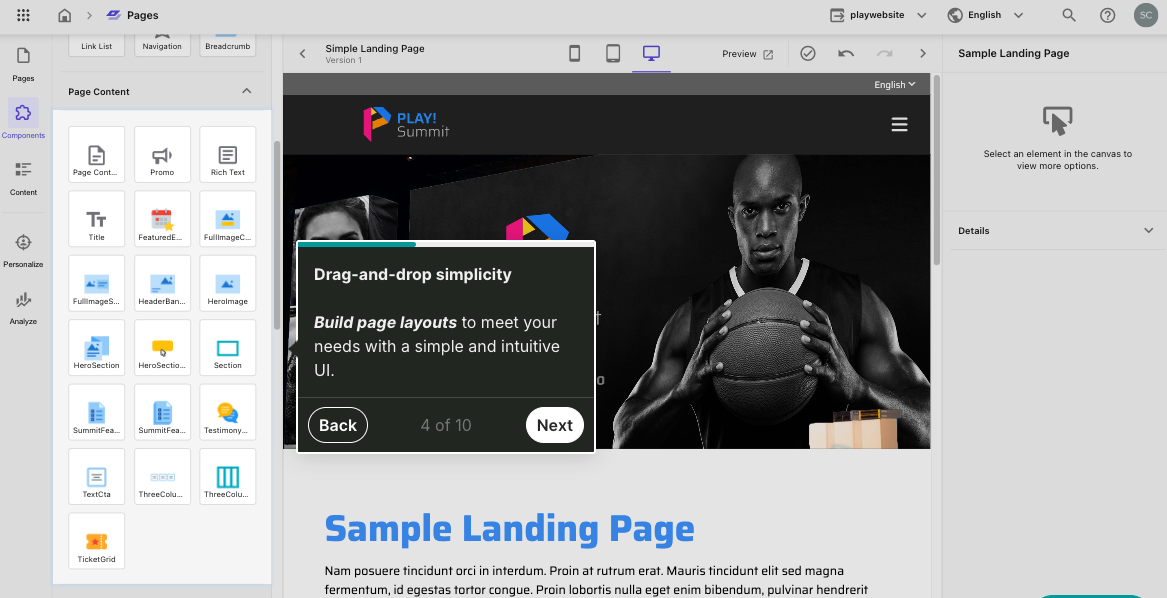
Source: Sitecore
Integration capabilities
Sitecore offers REST API, GraphQL, and integrations with popular AI tools such as OpenAI and ChatGPT. The platform is based on a composable DXP architecture, which allows different microservices to be combined into a cohesive ecosystem. Sitecore integrates natively with Microsoft Azure, Salesforce CRM, Adobe Creative Cloud, and marketing automation systems like Marketo and Pardot.
Scalability
Sitecore runs fully in the Microsoft Azure cloud with automatic scaling of resources based on workloads. The platform uses a global CDN and advanced real-time personalization mechanisms. Sitecore can support millions of concurrent users and is designed for global multilingual deployments.
Security
Sitecore meets enterprise security standards with ISO 27001, SOC 2, and GDPR compliance. The platform offers end-to-end data encryption, advanced permission systems, and integration with Active Directory and other SSO solutions.
Support and community
Sitecore offers dedicated enterprise support with guaranteed response times and access to a global ecosystem of certified partners. The platform holds annual Sitecore Symposium conferences and offers extensive training and certification programs. Sitecore Community Portal provides access to documentation, best practices, and opportunities to collaborate with other developers.
10. Magnolia CMS
Magnolia is a Java-based enterprise CMS platform available in Community Edition (open source) and Enterprise Edition with additional commercial features. Magnolia is distinguished by its modular architecture, ease of integration with Java systems, and the ability to create custom business applications.
Usability and intuitive operation
Magnolia offers an intuitive drag-and-drop editor and a tab system for organizing different types of content. Visual SPA Editor allows editing single page applications directly in the interface. The platform requires knowledge of Java for advanced customization, but basic content management is available to non-technical users.
Integration capabilities
Magnolia offers a broad set of enterprise connectors for systems such as SAP, Oracle, Salesforce, and Adobe Creative Suite. The platform supports REST API, GraphQL, and full compatibility with modern JavaScript frameworks. Magnolia can operate as a headless CMS via Content Fragments and the GraphQL API.
Scalability
Magnolia is based on a robust Java enterprise architecture with support for clustering, load balancing, and horizontal scaling. The platform can handle large enterprise sites with thousands of pages and millions of page views per day. The system offers advanced multi-level caching mechanisms and CDN integration.
Security
Magnolia meets enterprise security standards with ISO 27001:2013 certification and SOC 2 compliance. The platform offers JAAS authentication, LDAP/Active Directory integration, and advanced permission systems at the content and feature levels.
Support and community
Magnolia has a network of more than 200 certified partners and holds annual DevDays conferences. The platform offers 24/7 enterprise support with dedicated managers. Magnolia Community provides access to documentation and a support forum.
11. Optimizely
Optimizely is a digital experience platform that supports CMS, A/B testing, and personalization. It is distinguished by advanced content testing and personalization capabilities based on user behavioral data.
Usability and intuitive operation
Optimizely offers a Visual Builder for marketers to create and test different versions of content without knowledge of code. The platform integrates Digital Asset Management with AI-based tagging for easy multimedia management. Optimizely Opal - an AI assistant - automates routine marketing tasks and helps optimize conversions.
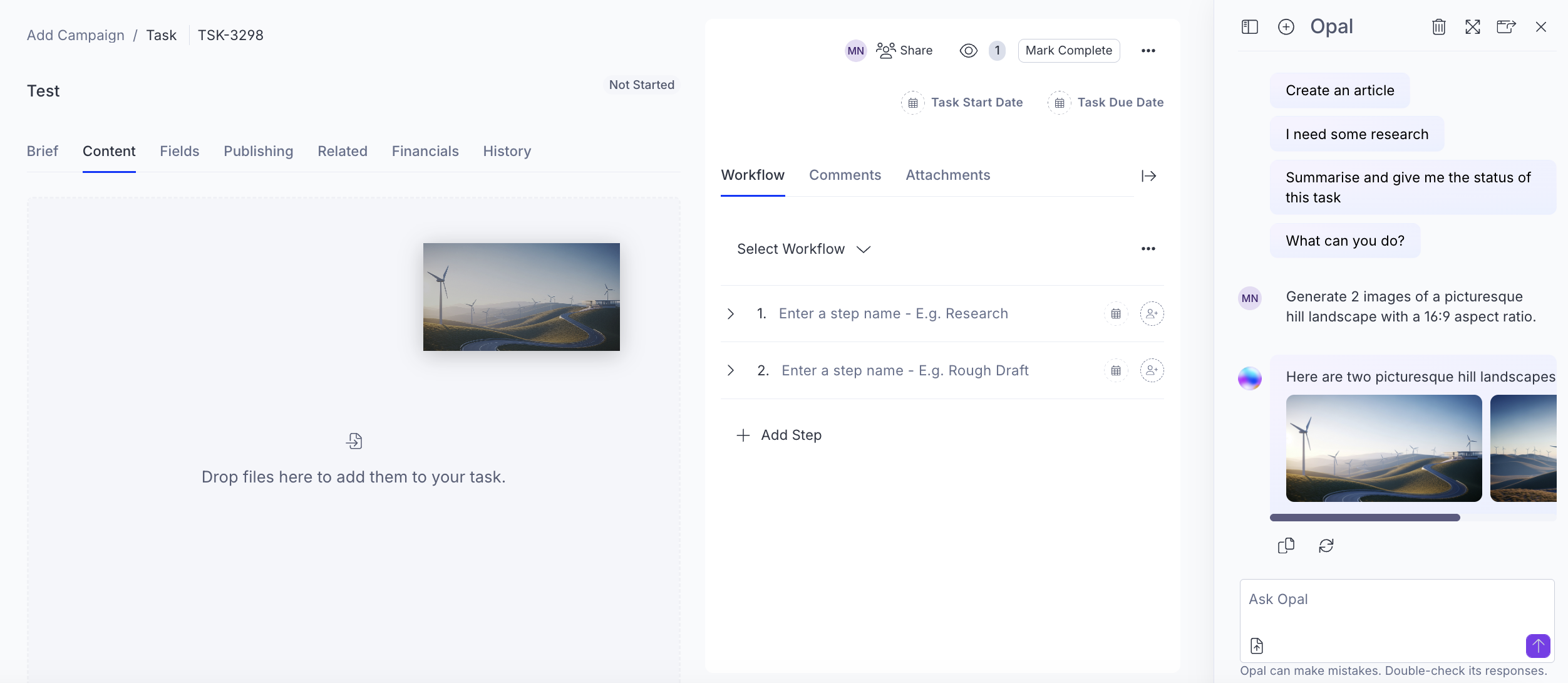
The usage of Optimizely Opal in practice. Source: Optimizely
Integration capabilities
Optimizely integrates natively with the Microsoft Azure/.NET ecosystem and offers REST APIs and GraphQL for custom integrations. The platform connects to popular analytics (Google Analytics, Adobe Analytics), CRM (Salesforce, HubSpot), and marketing automation (Marketo, Pardot) tools.
Scalability
Optimizely is based on .NET Core/.NET 8+ with a microservices architecture that provides high scalability and performance. The platform runs on a SaaS-first model with automatic scaling in the Microsoft Azure cloud. The system can handle millions of experiments and customizations simultaneously without affecting site performance.
Security
Optimizely meets enterprise-grade security standards, offering regular updates and hosting on the Microsoft Azure platform with a web application firewall. The platform offers data encryption, advanced permission systems, and integration with enterprise security solutions.
Support and community
Optimizely offers 24/7 enterprise-class support with dedicated managers and access to a global network of certified partners. The platform organizes annual Opticon conferences and provides extensive training and certification programs. The Optimizely community portal provides documentation and best practices.
12. Kentico
Kentico Xperience is a CMS and digital experience platform that combines content management functions with marketing automation, e-commerce, and customer data management in a single solution. The platform is particularly popular in the mid-market segment and among organizations looking for a transparent licensing model.
Usability and intuitive operation
Kentico offers a Page Builder with real-time preview, which allows the marketing team to create pages without knowledge of code. Content Hub uses AI-based transformations to automatically generate content variations for different channels. The platform offers a visual email builder and tools for managing marketing campaigns.
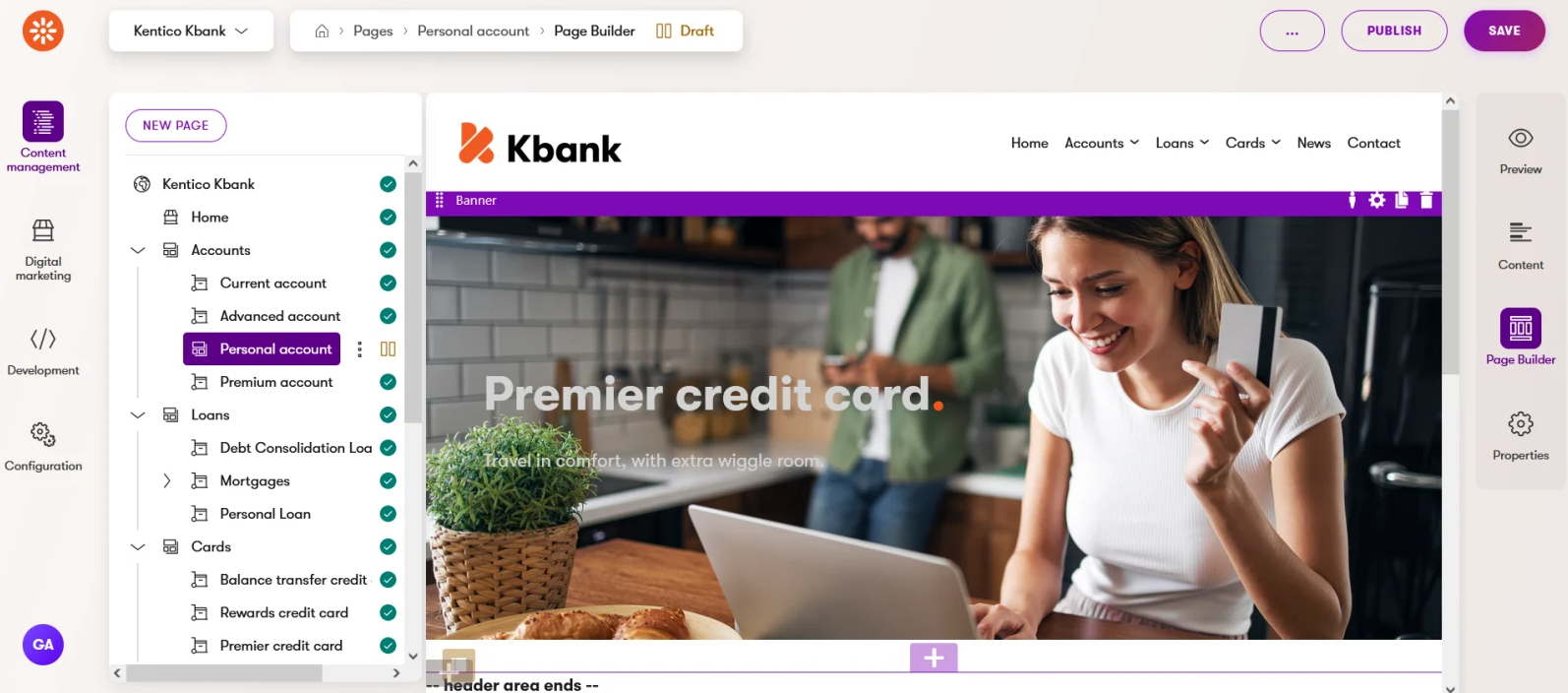
Source: Kentico
Integration capabilities
Kentico offers REST API, GraphQL and native integration with the .NET and Microsoft Azure ecosystem. The platform has ready-made connectors for popular CRM systems (Salesforce, Microsoft Dynamics), email marketing tools and e-commerce platforms. Kentico integrates with Google Analytics, Facebook Pixel and other conversion tracking tools.
Scalability
Kentico is based on .NET 8+ with a microservices architecture that provides scalability and performance. The platform offers native cloud support with hosting on Microsoft Azure and integration with CDN. The system can handle medium and larger sites in the mid-market segment with automatic resource scaling.
Security
Kentico meets enterprise security standards with regular updates and penetration testing. The platform offers GDPR compliance through built-in consent management tools and role-based access control.
Support and community
Kentico offers 24/7 global support with a transparent "land and expand" licensing model that allows for incremental expansion of functionality. The platform has a network of certified partners and holds regular webinars and conferences. Kentico Community Portal provides access to documentation, tutorials and a support forum.
How to choose the best CMS platform in 2025?
Choosing the right content management system requires a systematic analysis of an organization's needs and matching functionality to business goals. Each platform has its own strengths and optimal applications, so understanding the specifics of your own project is key.
Key questions before choosing
Identify project goals and requirements. The first step is to define the main goals of the website. Is it mainly to publish informational content, support sales processes, or integrate with business systems? A simpler information site requires different functions than an elaborate customer self-service portal. It's also worth determining the planned number of users, the amount of content, and the projected growth in the future.
Consider the resources and competencies of the team. Available technical competence is critical to the choice of platform. Teams familiar with Microsoft technologies will naturally lean toward .NET-based systems (Umbraco, Kentico, Sitecore). Organizations without a strong development background should consider SaaS solutions or CMS platforms with a low entry threshold. It is also important to consider the time needed to train the content teams.
Consider scale and growth perspective. Choosing a CMS platform is a long-term decision, so think about the organization's future needs. Is there a planned increase in website traffic? Will the company expand into new geographic markets? Are new features or integrations expected to be added? The platform should be flexible enough to support the organization's growth without requiring a costly migration.
Security and regulatory compliance. For organizations operating in regulated sectors (finance, medical, public sector), security compliance may be a legal requirement. Companies serving EU customers must ensure GDPR compliance, while ISO27001-certified organizations need a platform that supports these standards. It is also crucial to take into account data storage requirements and their location.
Need help selecting and implementing a CMS platform? We have years of experience in building and implementing Drupal-based content management solutions. We can help you analyze your needs and make a recommendation tailored to your organization's specifics.











